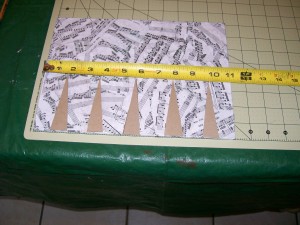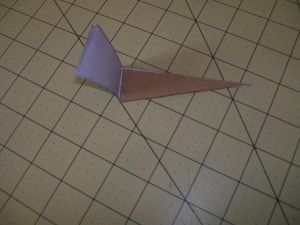Nesting tables are great space savers. You can store the smaller pieces under the larger piece when not in use and pull the smaller pieces out when you need to use them. I picked up this set of nesting tables for a great deal. It was missing the top inserts, but with a little re-purposing, paper and paint, I gave it a backgammon board look that really stands out.
You will need:
– Piece of furniture with missing inlay that have the length and width dimensions similar to that of a backgammon game board
– MDF board thin enough and large enough for the inlay
– Primer – I used black
– Paint – I used black satin
– Sponge paint roller
– Decoupage glue – I used Mod Podge matte
– Small paint tray
– Wipe on varnish – I used Minwax Wipe-On Poly in satin
– 220 Grit (or higher) sand paper block
– Lint free cloth
– Fiskars cutting matte with the angle pattern
– Rotary cutting tool with standard blade
– Several card board pieces (don’t have? Use the sides of a cereal box )
– Several wood blocks (don’t have? Use a few decks of cards)
– Ruler and pencil
– Drop cloth
– Several clean rags
– Decorative paper, I used sheet music, but you can use 3 varying scrapbook paper designs in the style and color of your choice.
-
10-15 pages for background ( I photo copied sheet music)
- 3-6 pages for backgammon pips in 1st color (I photo copied sheet music)
- 3-6 pages for backgammon pips in opposing color ( I scanned and inverted sheet music image on computer to make black with white print)
Furniture
1) Lightly sand furniture piece and wipe down with damp cloth.
2) Apply primer, let dry per directions
3) Apply paint, let dry per directions
4) Apply 3 coats of wipe on varnish, let dry per directions.
Measure, cut and paint inlay area
-Measure and cut mdf to size of inlay measurements, less about 1/8” all around.
Tip: The inlay area sides may not be totally equal with each other. Make sure to measure and cut based on the actual measurements, not an equal square or rectangular because your insert may not fit.
-Apply paint or primer to mdf pieces. This is an important step because the decoupage will adhere much better to the mdf with a coat of paint or primer on it.
Backgammon Design Inlay
This backgammon design is not to game specifications. I was just trying to get the look of a backgammon board. The points on a backgammon board are called pips. I will refer to them that way in the directions. A backgammon board will have a series of 6 pips on each side, 3 in one color and 3 in an opposing color with the opposite side of the board showing the exact opposite layout. For design purposes, the number of pips can vary depending on the size of your inlay. I had to go with 5 pips on the smaller table.
Measuring to determine size of pips
-Measure your inlay width or short side
Both of my inlays = 8”
-Take your short side measurement and divide that in half
8” divided by 2” = 4”
-Now, subtract ½”
4” minus ½” = 3-1/2”
My “Determined pip size” is: 3-1/2” long. This will leave 1” space between opposing pips.
Making the insert background
-Using the paper with your background design crumple the paper, then rip the paper into pieces.
-Apply the pieces to the insert with decoupage, making sure to wrap them around the back side. Once dry apply 2 more coats of decoupage to front and back of insert.
Since I used sheet music, I had to apply a layer of dark glaze over the background to darken it just a bit, so that when I apply my white pips, they will show up. If you background scrapbook paper is a different design from your pips, you will not have to do this step.
Making pip template
-Make enough template pieces to lie across one side of insert. I made 6 pieces.
-Using cardboard (sides of a cereal box works best) lay cardboard down on cutting mat directly over the angular markings.
-With a ruler and pencil, draw the lines across the cardboard to create large points.
-Line your ruler up with the penciled lines and cut along the line using your rotary cutter.
-Lay your points down along the length of a ruler, squaring it up, so that you can mark a straight line across the bottom of the point at the “Determined pip size”, which is 3-1/2” for my design.
-Using the ruler and rotary cutter, cut your points along that line.
Now you have a backgammon pip template.
Making pips
-Figure out how many pips you will need of each design and how many sheets of decorative paper you will need to make the pips. I made 11 pips of each design, plus a few extra to be safe.
Tip: You can cut several layers of paper at the same time if your rotary cutter will allow. I used 8-1/2” x 11 sheets and folded them in half. With scrapbook paper, you may be able to cut or fold each sheet into four sections.
-Lay your sheet or sheets down on cutting matt directly over the angular markings.
-With a ruler and pencil, draw the lines across the paper to create large points.
-Line your ruler up with the penciled lines and cut along the line using your rotary cutter.
-Lay your points down along the length of a ruler, squaring it up, so that you can mark a straight line across the bottom of the point at the “Determined pip size, plus 2 inches, which is 5-1/2” for my design.
-Using the ruler and rotary cutter, cut your points along that line.
You should now have your backgammon pips, plus 2 inches.
Dry fit your layout
-Using the cardboard pip templates, lay them down on side of the insert to dry fit the position of the pips. You can lay a ruler down along side to help, if needed.
-Once you are happy with the way your dry fit looks, slide each pip off the side of the insert about ½”.
-With a pencil, make a mark on each side of the pip close to the edge of the insert.
Dry fit and apply your pips
-Line your paper pips up with one of the cardboard pips and fold your paper pips over the cardboard pip at the bottom. You can do this in several layers.
-Fold your paper flap back on itself
-Lay down a row of wood blocks. Tip: You can use a few decks of cards if you do not have any wood blocks.
-With your insert laying on the wood blocks, dry fit your paper pips on the insert, lining them up with the pencil marks. The paper flaps should hang over the side.
-One by one, apply your paper pips to the insert with decoupage, adhering the flaps onto the back side. Let dry.
-Apply 2 more coats of the decoupage to front and backside of insert, allowing dry time in between and about at least 2 days dry time for the last layer.
Dry fit and attach your insert into place
-Lay your insert into insert opening on the furniture. If it fits, that is great!!!
-If it doesn’t fit, you will need to sand down the sides of the insert until if fits. You want it to lay into the insert opening as flush as possible.
-Once the insert fits into opening, remove the insert and apply a bead of glue along the ridge of the insert opening. Attach insert into opening securely and let dry 24 hours.
Final topcoat
-Apply 3 coats wipe on poly coat varnish to the insert and surrounding top of the table.
Allow dry time in between coats per topcoat directions.






























Leave a Reply